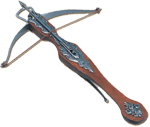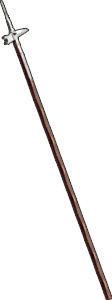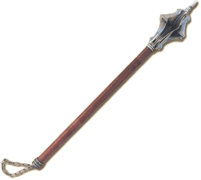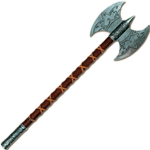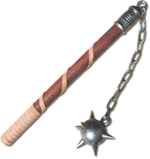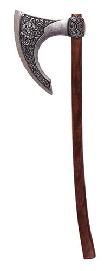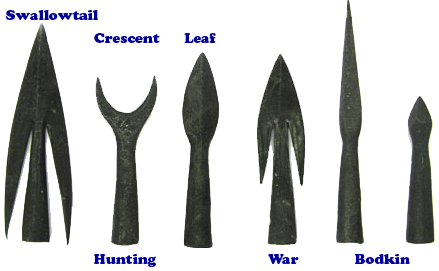Weapons
The campaign weaponry and armour is set to that commonly available in the 14th-15th centuries. Whilst some weapons, such as great swords, may first have been seen during the 15th Century they were not readily available until later. the weapons are those designed to deal with up to early plate armour, that is not fully covered fully articulated plates but multiple individual pieces that leave holes in the armpits, wrists, knees and elsewhere.
This is a gaming choice as fully plated armour is simply invulnerable to many weapons/creature attacks so cannot be modelled simplistically. There are a few weapons available specifically designed to counter plate e.g. pollaxes, maces, these may gain certain bonuses against those specific armour types.
Weapon Groups
Although all weapons are used with a slightly different technique, many weapons are similar so if one can be used effectively another can be used unskilled (1d8) but at the same bonus. Each weapon belongs to a category and training for one weapon confers benefits to others in the same category.
The categories are:
Types and groups
Weapons in the same group are used at skill -1 (affects hit & damage).
Weapons in an unknown group but of the same type are used at -3 levels (min = 0) (attack, damage).
Weapons of a different type are unskilled 1d8 (but may still use fighting skill), damage -4 levels
Types
- 1 handed
- 2 handed
- Ranged
Groups
- Slashing
- Pointy
- Chop & bludgeon
- Pole arms
- Great weapons
- Hurled
- Assisted (mainly bows)
For each size of creature the damage level and minimum strength requirement is adjusted by their size.
Damage
The maximum and average damage from a weapon rises as your ability increases.
Roll all the dice and discard the lowest (keep at least 1).
| Weapon | Damage | Level | Average | Average vs armour |
|---|---|---|---|---|
| Pathetic | d1 | 0 | 1 | 0.5 |
| Pummel | d2 | 1 | 1.5 | 1 |
| Knife | d3 | 2 | 2 | 1.5 |
| Staff,Dagger, Bow | d4 | 3 | 2.5 | 1.8 |
|
2d4 | 4 | 3.1 | 2.5 |
| Side arms (Sword) |
d6 / d4 | 5 | 3.9 | 2.8 |
| Side arms (-1 to hit) |
d6 / d6 | 6 | 4.5 | 3.5 |
| Great weapons (+1 to hit) |
d8 / d6 | 7 | 5.2 | 4.3 |
| Great weapons (+0 to hit) |
d8 / d8 | 8 | 5.6 | 4.5 |
| Great weapons (-1 to hit) |
d10 / d8 | 9 | 6.4 | 5.3 |
| d12 / d8 | 10 | 7.4 | 6.0 | |
| Lance charge | 2d12 | 11 | 8.5 | 7.3 |
| d10 / d6 / d4 | 12 | 9.6 | 8.3 | |
| d12 / d6 / d4 | 13 | 10.6 | 9.0 | |
| d12 / d8 / d6 | 14 | 12.0 | 10.8 | |
| d12 / d10 / d8 | 15 | 13.58 | 12 | |
| 3d12 | 16 | 16.0 | 13.8 | |
| 3d12+2 | 17 | 18 | 15.8 | |
| 3d12 +4 | 18 | 20 | 17.3 | |
| 3d12 +6 | 19 | 22 | 19.3 | |
| 3d12 +8 | 20 | 24 | ||
| 3d12 +10 | 21 | 26 | ||
| 3d12 +12 | 22 | 28 |
Armour types assumed as averaging across x1.2, x1, x.75, x.67
Weapon Fighting Styles
There are three types of weapon
- Cutting (e.g. swords)
- Bludgeon / Chop (e.g. maces, hammers, clubs / axes, some heavy swords)
- Pierce (e.g. spears, daggers / arrows)
- Cut / slash
- Drawing a sharp edge across the body
- Chop
- Heavy blade normally with a curved edge to focus the force on a small area
- Bludgeon
- Lump of metal/wood... Spreads the impact more than chop but less likely to slip with a glancing blow against angled armour (+3 to hit plate).
- Pierce / Thrust
- Pointy
Although different weapons would be differently effective against any specific armour, for example mail will stop completely a normal sword blow from cutting you, for simplicity this is ignored and all weapons are modelled using an aggregate damage type except for special scenarios, e.g. skeletons are resistant to piercing weapons as the pass between the bones.
One handed weapons (swords, maces...) are normally classified as side arms, i.e. weapons to use when your main weapon has been disabled. In some cities you may be allowed to carry side arms, you won't be permitted to carry main weapons (long swords, poll axes, spears). Thus in city fighting has limited damage potential. Similarly you may carry a buckler but a medium shield would be frowned upon.
Although the bigger heavier blunt weapons do more damage they are more difficult to wield and tend to have attack penalties.
Weapons
| Weapon | Atk / def |
Str | Dex | Type | Damage | Width needs |
Notes |
|---|---|---|---|---|---|---|---|
| One handed weapons / side arms | |||||||
| Town items (Encumbrance = 1/3) | |||||||
| Knife / cleaver / kitchen implement | -1 | X | Pierce/chop | d3 | 3' | off hand use possible. | |
| Kosh | -1 | X | Bludgeon | d4 | 5' | ||
| Dagger / Stiletto | -1 | X | Pierce | d4 | 3' | off hand use possible | |
| Side arms (Encumbrance = 1) require 90° | |||||||
| Club | -1 | X | Bludgeon | d6/d4 | 5' | ||
| Mace / Morning Star / Hammer | -1 | X | Bludgeon | 2d6 | 5' | ||
| Battle-axe | -1 | X | Chop | 2d6 | 5' | Or pierce at damage disadvantage | |
| Morning Star Flail | -1 | X | Bludgeon | 2d6 | 8' | Ignores shields. Dex +2 required | |
| Short sword / Cutlass | 24"-28" blade | ||||||
| Falchion / Messer | -1 | X | Chop | 2d6 | 6' | Single edged, slight curve, pointed 25"-30" blade | |
| Scimitar | X | Cut | d6/d4 | 5' | 12th Century+, single edged, curved, good on horseback | ||
| Side sword / Rapier | X | Pierce | d6/d4 | 5' | 16th Century+ (NOT available) | ||
| Arming sword | X | Cut | d6/d4 | 5' | Double edged 28"-31" blade | ||
| Bastard sword | -1 | X | Cut | d6/d4 | 5' | ||
| Two Handed Weapons | |||||||
| Great Weapons (Encumbrance = 2) require 120° | |||||||
| Dane axe / Dwarf Axe | -1 | X | Chop | d10/d8 | 6' | Damage advantage against flesh | |
| Dwarf Hammer | -1 | X | Chop | d10/d8 | 6' | Damage advantage against metal armour | |
| Bastard sword | X | Chop | d6/d6 | 6' | |||
| Sword - Long | X | Cut | d8/d6 | 7' | 33"-43" blade | ||
| Sword - Great | X | Chop | 2d8 | 8' | 16th Century only (NOT available) | ||
| Long pole arms (Encumbrance = 3) require 60° | |||||||
| Spear | +1 | X | Pierce | d8/d6 | 3' | REACH, can be used in two ranks | |
| 0 | X | Chop | 2d8 | 8' | REACH
Spear tip - Acts as a Dex weapon but with combat disadvantage |
||
| Not really weapons of war | |||||||
| Staves (Encumbrance = 2) Two Handed | |||||||
| Quarterstaff ‡ | X | Bludgeon | 2d6 | 9' | REACH, Swirly attack* Act as blunt spear, damage disadvantage, -1 to hit Add spear tip - has to hit disadvantage |
||
| Wizard's knobbly staff ‡ | X | Bludgeon | d6/d4 | 6' | Swirly attack*
Use as short blunt spear @ damage disadvantage, -1 to hit Add spear tip -1 to hit, +1 damage |
||
| Oddities | |||||||
| Lance | -1 | X | Pierce | 2d12 | - | Gallop riding skill required | |
| Martial arts | -1 | X | Bludgeon | d4 | 3' | No Parry / Attacks vs dodge | |
| Brawling | -1 | X | Bludgeon | d2 | 3' | No Parry / Attacks vs dodge | |
Weapon width needs changes by 20% for each body size category (Damage goes up by ~13% slowly reducing as level goes up).
REACH = Weapon gets first strike when closing regardless of initiative. All these are REACH 10'
The weapon bonus is a combination of its speed and reach, long/medium/short (e.g. pole arm/sword/dagger)
¿ The width needed includes 3' for a normal human, this should be adjusted for smaller or larger creatures. It is the width required to use the weapon without too much hindrance or where you are fighting next to someone so there is some shared space. Insufficient space up to 2' incurs disadvantage to hit and damage, beyond that it is not possible to use the weapon.
† Riding check (9) required each round of combat or no attack.
‡ The military quarterstaff is 7-9' long a wizards staff <6' (and old and knarly).
* Swirly attack: +3 dmg levels and opponent gets an opportunity attack before you hit that disrupts your attack if it hits.
Needs 2x the normal space (12' diameter) it may be whirled with both hands at one end for additional damage. This takes up two attacking slots against a defender so not against anyone in a corner and sole attacker normally. This can only be done once against any opponent (they see it coming next time and disrupt it).
Missile weapons
| Weapon | Accuracy | RoF* | Damage Type |
Adv |
Long |
Enc | |||
|---|---|---|---|---|---|---|---|---|---|
| Tumbling | |||||||||
| Axe - hand | -1 | d4 | 1 | Chop | - | 10' | 25' | 0 | |
| Dagger | 0 | d2 | 2 | Pierce | 10' | 15' | 25' | 0 | |
| Streamlined | |||||||||
| Spear 5' / Javelin | 0 | d4 | 1 | Pierce | 10' | 20' | 50' | 2 for ≤ 3 | |
| Dart | +1 | d2 | 2 | Pierce | 10' | 20' | 100' | 0 | |
| Bows | |||||||||
| Bow | +1 | d4 | 1 | Pierce | 15' | 40' | 100yds | 3 | |
| Crossbow | Pellet £ | +1 | d2 | 1 | Pierce | 10' | 20' | 60' | 1 |
| Light | +2 | d3 | 1 | Pierce | 20' | 40' | 120yds | 2 | |
| Heavy | +2 | 2d4 | 1/2 | Pierce | 20' | 40' | 200yds | 3 | |
| Oddities | |||||||||
| Grenade thrown † | Rock | -1 | 2d4 | 1 | Bludgeon | 10' | 10' | 40' | 1 |
| Oil flask ¥ | -1 | 0 | 1 | n/a | 10' | 20' | 40' | 1 | |
| Blowgun | +1 | - | 1 | Pierce | 5' | 10' | 20' | 1 | |
| Net (& Trident) | -1 | - | 1 | - | 5' | 10' | 20' | 3 | |
| Sling | Hand | -1 | d4 | 1 | Bludgeon | 15' | 40' | 150' | 0 |
| Staff ‡ | -1 | d8 / d4 | 1 | Bludgeon | - | 30-40 yds | 120yds | 2 | |
* If the rate of fire is >1 you do not take the multiple action penalty
† Flasks and other thrown objects come under the grenade skill, however the range and other statistics are different due to the weight of the objects.
‡ Hurls grenade like objects. Due to the high arcs required it has a minimum range of 30 yards. 30 yards - 40 yards is counted as short range, there is no point blank range.
¥ Oil flasks need a manoeuvre to prepare and a minor to light (unless someone is throwing a lighted torch, which must also hit)
£May be dual wielded
Ranges
Shooting at point blank or long range grants you combat advantage / disadvantage on the skill and damage rolls.
Weapon Descriptions
Daggers
Daggers are primarily thrusting rather than slashing weapons.
Stiletto
A stiletto is a short knife or dagger, with a long slender blade of various designs. This dagger is a stabbing weapon, its narrow shape ending in a rigid pointed end allows it to penetrate deeply. It is not suited for cutting, even with edged examples.
It is popular as a tool against heavily armoured knights when in close combat. The thin blade can easily pass through most chainmail, or find its way through tiny gaps in a knight's armour. It ignores armour completely and causes wounds if the fighters have entered wrestling range.
Short Sword
Short swords are like the Roman Gladius, often without cross-guards and used solely as a stabbing weapon.
Swords
The decisive characteristic is the length of the grip. Indeed, some blades can be made into either a typical arming sword, or a typical bastard word, depending on the hilt that is attached to it. As a general rule, if, when handling the sword with both hands, the left hand does not fit on the grip but holds the pommel, it is considered an arming sword. If the left hand fits 2 fingers on the grip, it is a bastard sword. If both hands fit then it is a two handed sword. The grip will frequently have a distinctive 'bottle' shape to facilitate this. If the grip is as long as or longer than the wielder's lower arm (ell) it is a usually considered a two-handed sword proper.
Swords are designed to be used as slashing weapons throgh some will incorporate a degree of cut and thrust depending upon the blade.
Arming Sword
Also known as a Knights sword or Knightly sword and often erroneously ass a long sword.
Typically used with a shield or buckler, the arming sword is the standard military sword of the knight. The short crossguard necessitated the use of a shield/buckler to protect the extended sword hand. In the absence of a shield the empty hand could be used for grabbing or grappling opponents. The arming sword was overall a light, versatile weapon capable of both cut and thrust combat, however it was largely ineffective against plate armour and even mail was excellent at deflecting the typical glancing blows that were dealt.
Side sword (not available)
A lighter more advanced sword similar to the arming sword but depends upon fast movement of the blade rather than strength. More expensive than arming swords as they require better steel.
Scimitar / Cutlass
Scimitars are an oriental sword with a curved blade, cutlasses are more curved and with heavier blades. Both are designed as slashing weapons with little if any capability to thrust. Heavier than an arming sword they gain more impetus but without the thrust action are less versatile though the shorter length means they can typically be used in more confined areas.
Long Sword
Designed to be used with two hands and coming up to shoulder height.
Bastard Sword
A bastard sword is a sub-category shortish long sword which it is possible to get two fingers of the second hand on the grip and the rest of the hand around the pommel. They could be used with one hand if necessary but would be more cumbersome and not as effective as an arming sword, neither are they as powerful as a long sword when used with two hands. They are however a compromise that allows them to be used with one or two hands.
Great sword
A two handed or great sword such as the Zweihänder or Claymore is one that is as large as the wielder and cannot fit in a sheath. They are too cumbersome to be used single handedly.
Great swords are too big to use normal sword techniques with and are unable to easily parry or riposte attacks, instead their length is used to like a pole arm to keep the opponent at reach.
Note: Great swords are Renaissance period weapons and as such beyond the time period of the campaign.
Simple Hand weapons
Mace
When metal armour and chain mail protects against the blows of edged weapons and blocked arrows and other projectiles solid metal flanged maces and war hammers are able to inflict damage on well armoured knights, as the force of a blow from a mace is large enough to cause damage without penetrating the armour. Flanged maces have protruding edges of metal that allow it to dent or penetrate even the thickest armor.
Morning star
The morning star is a weapon consisting of a spiked club resembling a mace, usually with a long spike extending straight from the top and many smaller spikes around the particle of the head.
War Hammer
War hammers were developed as a consequence of the ever more prevalent metal armors of the battlefields. The war hammer could deal blows of force to the target and by impact alone do damage without penetrating the armour. The spike end could be used for grappling the target's armour, reins, or shield, or could be turned in the direction of the blow to pierce heavier armours.
Axes & Pole arms
Axes and pole arms are related as most pole arms include an axe blade and a hook to help unseat riders or trip oppnents.
Axes
Battle-axe
Traditionally this was a large bladed axe two-handed weapon like a Dane axe but smaller one-handed versions were sometimes carried as side arms. The axe was superseeded by the sword until plate armour, against which swords had little effect. The battleaxe in a changed form then made a reappearance.
Used by knights when fighting against other knights as it is designed as an anti-armour weapon. It consists of an heavy curved axe blade for cutting and crushing armour (as well as anything else!),and a normally a curved back spike useful for puncturing armour, as well as hooking shields, bits or armour, people etc.
In use it may either be treated as a slashing weapon or a piercing weapon by hitting with the spike.
Pole Arms
The spike end could be used for grappling the target's armour, reins, or shield, or could be turned in the direction of the blow to pierce even heavy armour. Against mounted opponents, the weapon could also be directed at the legs of the horse, toppling the armored foe to the ground where he could be more easily attacked.
Pole arms are all 2 handed weapons.
There are a lot of pole arm types and they all merge into one another sometimes only with subtle differences, on top of that the same weapons are often called by different names by different people. Therefore read these descriptions with a pinch of salt.
Given the almost infinite variety I've only included a limited selection that
are obviously different such that they will have an effect on gameplay.
Quarterstaff
A simple weapon used as a training weapon for the other polearms.
Pollaxe
Pollaxes (not pole axe, it's from old English poll or head ) are the favoured weapons of knights in combat against well armoured opponents as swords can not penetrate plate armour effectively. they are generally about 5' long but range from 4' to 6'.
Pollaxes normally have a hammer on one side and an axe or beak (spike) on the other, surmounted by a steel spike. In some cases it can be an ax head and a beak. The base would be a spike and would often be held in guard with the base spike forward.
Pollaxes were developed as a consequence of the ever more prevalent metal armors of the battlefields. The hammer headed pollaxe could deal blows of tremendous force to the target and by impact alone do damage without penetrating the armour.
Glaive-guisarme
The glaive-guisarme is a glaive or cutting blade with with a guisarme or hook on the rear face to help unseat riders.
Halberd
The halberd is an axe blade on the front with a hook on the rear for dismounting riders and a long spike on top.
Spear
Spears up to 8' long can be used in one hand and are ideal for keeping an opponent at range. When used with two hands they are significantly more powerful.
Oddities
Morning star-Flail
The flail is a medieval weapon made of one (or more) normally spiked weights attached to a handle with a hinge or chain.
- Unlike a sword or mace, it doesn't transfer vibrations from the impact to the wielder. This is a great advantage to a horseman, who can use his horse's speed to add momentum to an underarmed swing of the ball, but runs less of a risk of being unbalanced from his saddle.
- It is difficult to block with a shield or parry with a weapon because it can curve over and around shields or armor. It ignores 2 points of shield protection.
- The flail needs space to swing and can easily endanger the wielder's comrades.
- Controlling the flail is much more difficult than rigid weapons.
- If the flail was swung with enough force it can crack open plate armour and stun the wearer.
Trident
A three pronged military fork normally used with a net
Lance
Lances must be used on horseback when cantering or galloping, they are uncontrollable at a trot. The damage assumes you are cantering. Lances need the horse riding skill (you can't begin until you are 3rd level at riding) and then each riding level means you can train 2 levels of lance
i.e.
2nd level lance at 3th level riding, (Cantering only and at disadvantage)
4th level lance at 4th level riding, (Cantering normally or galloping at disadvantage)
6th level lance at 5th level riding, (Galloping at -1 skill)
...
If you are galloping you gain an additional d12 in the damage pool.
Nets
Nets may be thrown to snare either a character or their weapon. If used against a weapon they are not normally released, the net is used to make the weapon useless. A successful hit entangles the creature / weapon. Weapon attacks are made at +3, attacks against smaller creatures gain +1 for every 10% height difference from the thrower.
Touch
Touch attacks where the attacker does not need to strike flesh.
Missile Weapons
Thrown weapons such as the spear gain 1 additional damage level when dashing, at faster speeds you cannot effectively aim.
Bows (Cross & Hand)
Hand Bows
Short/horse bows and long bows are so similar that they count as one skill.
Horse bow
Previously known as a short bow. tink Turkish, Crimean-Tartar & Mongol bows.
Less than 4' long with a pull of under 50lbs.
Horse bows do not have the stopping power of a full long bow so operate at -2 damage levels.
They may be fired from horseback with the feat
Long bow
Approximately 6' long with a pull of up to 100-150lbs and gain damage bonus normally for high strength.
Arrows
There are many different arrow types, used for specialist purposes, the most common are. Only war arrows are used within the campaign.
- Bodkins
- Square or needle bodkins give low damage but high penetration. (penetrate all armour types unless otherwise restricted)
- War arrows
- Use against non-metal armoured warriors, they cause more damage as they are larger and may break off in the body.
- Swallowtail
- Used for large animals, high stopping power but heavy and innacurate. They have little to no penetration capability against armour (excluding natural hide) or natural scales.
- They are cutting weapons at all ranges.
- Crescent
- Used for knocking birds and small animals in trees, without impaling them to a high branch. They are slashing at all ranges.
- Leaf
- Normal hunting. They are slashing at all ranges.
Crossbows
Light and heavy crossbows are counted as only one skill.
Crossbows are easier to use and thus require less training than hand bows as once cocked they do not take any effort to maintain the pull, additionally they may be aimed by resting on a handy surface.
If a crossbow is supported such as resting on a rock then an additional +1 to hit is gained.
As crossbows have a pull of 150 lb. or more they need assistance from a mechanism to cock them. This will vary from a simple foot stirrup for a pellet crossbow through a spanning lever for a light to a full windlass for a heavy crossbow. This affects the time to span the bow and hence reduces the number of shots per round.
A crossbow will have a pull of 250lbs for a light one up to 1000lbs for a heavy, whereas a longbow would have an average pull of 80-100lbs and up to a maximum of 150lbs.
Pellet Crossbow
A one handed crossbow. These can be cocked by hand. These use small bolts that only cause stamina points.
Light Crossbow
Crossbows with a pull of under 250lb. These require a foot stirrup and belt hook or a spanning lever to cock the weapon.
Heavy Crossbow
Crossbows with a pull of over 250lbs. These require a windlass to cock the weapon.
Grenades
Max distance for a 1/2 lb flask = 90' + 10' x strength.
Slings
http://www.chrisharrison.net/index.php/Research/Sling
